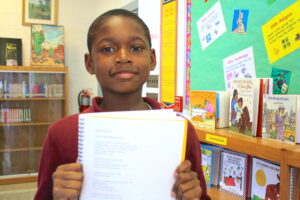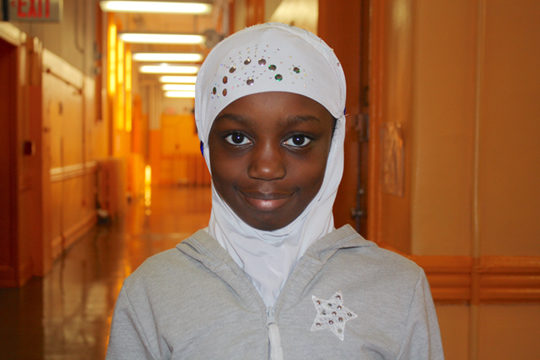
Ethan is a student in a Brooklyn, New York public middle school and was in a seventh-grade class taught by writer and T&W teaching artist Liz Arnold in the spring of 2015. He talked about his experience in the class and his plans for the future with editor Susan Karwoska this past May.
*
Ethan: At first, when I heard we were going to do poetry I was like, oh man, I don’t want to do this. I thought poetry was really boring and that all you do is rhyme words and things like that. But once I started doing it I really liked it. Miss Liz would play music for us and we would write to it. I really liked that and I started to adapt to poetry.
Teachers & Writers: Were you surprised at the things you wrote?
Ethan: Yes—I didn’t really think I could write the things I did and express myself like that.
T&W: Do you think you’ll keep writing poetry?
Ethan: Well, when I grow up I would like to be a basketball player, but as a backup plan I think I’d like to be an ELA teacher or a poetry teacher.
*
“Colors”
By EthanThem days of the week (you know)
Monday (blue), Tuesday (gray), Wednesday
(feels like a porcupine), Thursday (orange)
Friday (red), Saturday (purple),
Sunday (jelly fish)Monday that sad and blue day
That’s what I say
Beginning of the week and school
Getting up I feel like a foolTuesday gray and sad all day
Dark and gloomyWednesday porcupine I feel fine like I’m
getting stabbed
They call it hump day
I wish it were another wayThursday orange bright as day
Wish it was Friday, but it’s okFriday red great great great
What a favorite day and color
Stay up late and drink orange juiceSaturday fun day
I get to see Amanda Panda
It’s littOh Sunday I’m stung
Now we’re back to square one
*
Lesson Notes
By Liz Arnold
Ethan’s poem was written in response to a two-part lesson about synesthesia, the intermingling of the senses, or experiencing one sense by stimulating another. (For example, Duke Ellington supposedly said that a D note looked like dark blue burlap while a G looked like light blue satin.) The phenomenon was popular in the 19th century’s Symbolist movement and was explored by a number of French writers including Rimbaud. For the first of two lessons, I brought in his poem “Voyelles” (translated as “Vowel Sonnet”), in which the poet assigns a color to each of the vowels. Five translations are available online at Wag’s Revue.
First, I explained synesthesia—that it’s an actual condition, and that many artists of all kinds, including the pop star Pharrell, claim to tap into it for their creativity. I tried to look for something in the room to help explain the sensation. There was a vibrant red plant in the room. I pointed to it and said, “There’s no right answer, but who in the room thinks that plant might be spicy if you ate it? Who thinks it would be bland?” They all raised their hand for spicy.
For the poem, I included the French text and the English, to expose students to the process of translation, and also to help teach etymology and language skills. “Voyelles” is ambitious for a seventh-grader, so I wrote a glossary to the right of the text for words like “lances,” “raptures of penitence,” “alchemy,” and “cow-parsley,” and I reviewed those words before we began reading the poem aloud. I asked some guiding questions about descriptive details and sensory language: What are your favorite visuals? Have you ever thought of describing a black velvet jacket as brilliant, buzzing flies? How does that make you feel? Why do you think Rimbaud describes O as a trumpet? Are there similarities? (Many will “see” the trumpet horn’s opening as an O.)
Next, using the five vowels as an example, I asked the students to brainstorm other small sets of things that we could write synesthesia poems about. Here are some things they came up with: days of the week, feelings, music genres, school subjects, and even the Seven Deadly Sins, as one boy suggested. The best examples were abstract nouns—concrete nouns already have sensory associations. That means food groups are out, and animals. Once we had some options, I asked the students to brainstorm on one set, feelings. What does pride taste like? Feel like? What’s its texture? What color is sad? Since the lesson around synesthesia can take some time, I ended the first lesson once the students had scribbled down some ideas.
For the second lesson, I brought in the lyrics to “Bold as Love” by Jimi Hendrix, where he describes colors as emotions, some personified. I played the song from YouTube on my iPhone, and the students read along as the music played. The language is much more straightforward and accessible than in “Voyelles,” so it was a great way to refresh the lesson. And who knew that Hendrix was influenced by Rimbaud? The students recognized the personification in this poem, so I used that as a starting point for discussion. Why is Queen Jealousy wearing green? (Shakespeare is credited with coining “green-eyed monster,” as it appears in Othello.) After we discussed the colors and their emotions, I reviewed the sets of items we’d discussed that would help structure a poem. I reminded them to use sensory language, as Ethan did in his poem about the days of the week. I especially like that he incorporated the sense of touch, mentioning jellyfish in the beginning, and referencing it again at the end, “Oh Sunday I’m stung.”
Photo (top) by Jade Triton
Teachers & Writers Magazine is published by Teachers & Writers Collaborative as a resource for teaching the art of writing to people of all ages. The online magazine presents a wide range of ideas and approaches, as well as lively explorations of T&W’s mission to celebrate the imagination and create greater equity in and through the literary arts.


